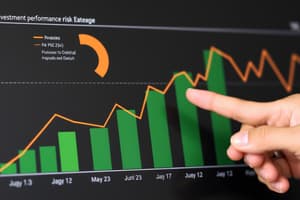Podcast
Questions and Answers
What does the allocation effect measure?
What does the allocation effect measure?
- The manager's total value-added performance
- Manager's ability to time the market segments effectively
- Manager's decision to over- or underweight a particular market segment (correct)
- Manager's ability to create specific market segment portfolios
How is the allocation effect calculated?
How is the allocation effect calculated?
- [(Rpi − Rbi ) + (Wpi - Wbi )]
- [(Wpi - Wbi ) * (Rbi − Rb)] (correct)
- [(Rpi − Rbi ) * (Wpi - Wbi )]
- [Wpi - Wbi ] / [Rbi − Rb]
What is good timing skill a matter of, according to the given text?
What is good timing skill a matter of, according to the given text?
- Timing the market segments effectively
- Creating specific market segment portfolios
- Balancing the portfolio weight and benchmark weight
- Investing more money in market segments producing greater-than-average returns (correct)
What does the selection effect measure?
What does the selection effect measure?
How is the selection effect calculated?
How is the selection effect calculated?
What is the manager's total value-added performance according to the given text?
What is the manager's total value-added performance according to the given text?
Which factor is important for good timing skill, based on the text?
Which factor is important for good timing skill, based on the text?
What does the term 'Wpi - Wbi' represent in the allocation effect equation?
What does the term 'Wpi - Wbi' represent in the allocation effect equation?
'Rpi − Rbi' in the selection effect equation represents:
'Rpi − Rbi' in the selection effect equation represents:
'(Benchmark weight) * (Portfolio return – Benchmark return)' in the selection effect equation calculates:
'(Benchmark weight) * (Portfolio return – Benchmark return)' in the selection effect equation calculates:
Which of the following is an essential attribute of a fund manager?
Which of the following is an essential attribute of a fund manager?
What is the main goal of superior security selection by a fund manager?
What is the main goal of superior security selection by a fund manager?
What is the primary purpose of attribution analysis in performance measurement?
What is the primary purpose of attribution analysis in performance measurement?
What differentiates allocation effects from selection effects in attribution analysis?
What differentiates allocation effects from selection effects in attribution analysis?
What is the significance of completely diversifying a portfolio relative to its benchmark portfolio?
What is the significance of completely diversifying a portfolio relative to its benchmark portfolio?
Which factor contributes to the actual return produced by a manager over an investment horizon?
Which factor contributes to the actual return produced by a manager over an investment horizon?
What can lead to superior risk-adjusted returns for a fund manager?
What can lead to superior risk-adjusted returns for a fund manager?
What are the two main considerations in performance management?
What are the two main considerations in performance management?
What is the desired attribute of a completely diversified portfolio in relation to its benchmark portfolio?
What is the desired attribute of a completely diversified portfolio in relation to its benchmark portfolio?
What contributes to deriving above-average returns for a given risk class as a fund manager?
What contributes to deriving above-average returns for a given risk class as a fund manager?
Which method does not contribute to evaluating expected returns?
Which method does not contribute to evaluating expected returns?
What are the limitations of peer group comparisons in evaluating expected returns?
What are the limitations of peer group comparisons in evaluating expected returns?
What does portfolio drawdown measure?
What does portfolio drawdown measure?
Which ratio measures risk premium per unit of risk?
Which ratio measures risk premium per unit of risk?
What does Treynor Ratio measure?
What does Treynor Ratio measure?
What does Information Ratio measure?
What does Information Ratio measure?
What does Jensen Measure calculate?
What does Jensen Measure calculate?
How can risk-adjusted performance be computed relative to any multifactor model?
How can risk-adjusted performance be computed relative to any multifactor model?
What is the aim of Sharpe Ratio?
What is the aim of Sharpe Ratio?
What is one limitation of peer group comparisons?
What is one limitation of peer group comparisons?
Flashcards are hidden until you start studying
Study Notes
- Investors evaluate expected returns using three methods: peer group comparisons, index returns, and risk factor models
- Performance assessment involves answering two questions: how did the portfolio manager perform, and what resources were used to achieve it
- Peer group comparisons use boxplots to display returns of a representative set of investors over a specific period, but they have limitations such as lack of adjustment for risk levels and difficulty in forming a large, meaningful group
- Portfolio drawdown measures how well the manager protected investors against losses, with maximum drawdown being the largest percentage decline in value from peak to trough
- Risk-adjusted performance measures include Sharpe Ratio, Treynor Ratio, and Information Ratio, which aim to measure a portfolio's total risk and performance relative to a benchmark
- Sharpe Ratio measures risk premium per unit of risk by subtracting the risk-free rate from the portfolio's return and dividing by the standard deviation of returns
- Treynor Ratio measures the portfolio's return in excess of the risk-free rate per unit of beta, indicating the slope of the fund's characteristic line and its position relative to the security market line
- Information Ratio measures a portfolio's average return in excess of a benchmark portfolio divided by the tracking error
- Jensen Measure, originally based on CAPM, calculates the difference between a portfolio's return and the return expected based on market conditions, with α indicating the manager's superiority or inferiority in investment ability.
- Risk-adjusted performance can be computed relative to any multifactor model, with attribution analysis decomposing the difference between a manager's total return and a benchmark policy portfolio into allocation and selection effects.
Studying That Suits You
Use AI to generate personalized quizzes and flashcards to suit your learning preferences.




